(VOVworld) - What do you often expect to see at a Japanese festival? Cherry blossoms, girls in kimonos, cosplayers, or sushi trays? Have you ever paid attention to lively stages on which hundreds of dancers wear eye-catching uniforms and always smile? This week’s Culture Rendezvous will introduce to you a unique Japanese summer dance called Yosakoi. Let’s see how popular it is among the Vietnamese youth.
Yosakoi is the most famous festival in Kochi city. Held over four days, the whole of Kochi is over-run by Yosakoi dance troupes. Entire streets are closed off to traffic, and teams of energetic dancers compete for the grand prize in the heat of mid-summer. Starting in the 1950s as a way to liven up the town of Kochi during a recession, Yosakoi dancing has spread throughout much of Japan since 2005 with hundreds of festivals and competitions. In Vietnam, Yosakoi is performed annually in Japan Sakura Matsuri Festival, which is held in Hanoi by the Japan Foundation Vietnam to introduce Japanese culture. Each year, the festival attracts more than 10 enthusiastic Vietnamese Yosakoi teams. Most of them are young dancers from different universities around Hanoi. Hoàng Minh Thành specializes in International studies at Hanoi University and is one of Hanu-yo Yosakoi Team’s leaders:“Our team was formed in 2009 with 8 members. Now we have nearly 100 dancers. All of them are students from our university. In the past, ancient Japanese people perform Yosakoi to cheer people up after war. When it became popular in Vietnam, we developed it into different styles. Each team is different from each other regarding costumes, music, instruments… For example, our group focuses on the combination of tradition, power and fascination.”
 |
| Hanuyo Yosakoi Team of Hanoi University in a Japanese Festival held in Hanoi in 2014 (Photo: Hanuyo) |
Normally, the highly energetic Yosakoi dance is based on Japan’s traditional movements and modern music. Spectators can now enjoy a fantastic variety of arrangements, from rock to samba, hip-hop, and enka - a kind of Japanese ballad. Performing materials also vary. Umbrellas, flags, paper fans, lanterns, and drums can be included. Those are chosen and used depending on each team’s style to create their impressions and highlights. One of the defining aspects of Yosakoi is the use of “naruko”, small wooden clappers held in the hands of each dancer. Trương Thị Thảo, a leader of Hanuyo Yosakoi team, elaborates:“Naruko” were traditionally used by Japanese farmers to scare birds away from crops. Now in the hands of Yosakoi dancers, a “naruko” becomes a percussion instrument. The original “naruko” has black and yellow beaters on a wooden body, but most modern Yosakoi groups create our own “naruko”, choosing colors and materials that match our performing costumes.”
 |
| "Naruko" is the most popular performing material in a Yosakoi dancing (Photo: vietbao.vn) |
The most popular costumes used by Yosakoi teams include “Happi” – a loose informal Japanese coat and “Yukata” - a kind of summer Kimono that can be seen in bright colors. Normally, members of a team wear similar costumes. Trần Thị Nhung is leader of the SIE Yosakoi Team from Hanoi’s University of Science and Technology:“Our team designed the costumes ourselves based on the content of the dance. We also make our own “naruko” and other performing materials. Each year, we change our costumes 1 to 2 times. We have a great passion for Japanese culture. Although it costs time, money, and effort, we still afford it to pursue our dream.”
There are two forms of Yosakoi performance: on stage and parades on the streets. There are a lot of dancers in a Yosakoi dance - from 150 up to 30,000 in many dozens of teams. Yosakoi requires coordination and energetic movements. Thành said:“In any kind of performance, smiling is the most important factor in a Yosakoi dance, which makes the spirit of the whole team. Everybody smiles when dancing. That’s the way we bring our optimism and cheerfulness to our teammates and the audience. High spirits play a vital role in Yosakoi. Another special thing in a Yosakoi dance is that each leg movement is a step forward.”
 |
| SIE Yosakoi Team performs in AKE OME Japanese Festival to welcome 2015 (Photo: SIE Yosakoi Team) |
For the past ten years, Yosakoi has widely developed in Vietnam. The Vietnamese Yosakoi teams also have their own dances with both Vietnamese traditional and modern music featuring Vietnamese culture. Nhung said:“We are the youngest in Vietnam’s Yosakoi community. At first, our team only performed at university’s activities. When we had our reputation, we were invited to perform in some of the most famous Japanese festivals held in Vietnam. Our dances focus on the high energy and the creativity of the youth. All of them are fun, lively, and refreshing. ”
What Yosakoi means exactly is open to interpretation, but the general sense is “let the good times roll”. Yosakoi is not only famous in Japan but also in Vietnam, particularly among the youth. Today, some Vietnamese secondary schools have also formed their own teams to perform in Japanese festivals or compete with each other. Yosakoi makes Vietnam and Japan closer, and helps them to understand more about each other’s culture and people.